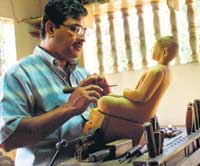| Plus |
|
|||
| Brassworker,
silversmith and the woodcarver... The Kalapuraya is a village of craftsmen of various trades. From brass workers to silversmiths, from batik workers to woodcarvers, they are all clustered together in one village. The artisans were selected on merit. Thus, although such a thing is not easy to judge they are among the best craftsmen around. Of the many families, I visited four, all engaged in different crafts. G.W Anura Kumara was busy carving the serene form of the Lord Buddha from a block of mahogany. His father, people had told me was among the best wood carvers of his time. Although not a connoisseur, one look at his products and I was convinced that Anura was not far behind. Among his creations are model cars. Model cars are made to the exact specifications of the original, but on a reduced scale. These are expensive products with a huge demand in the international market. The wooden models cost around USD 100 apiece and are usually more expensive than the die-cast ones. He showed me some of the models that he had been unable to finish, together with the original plastic models. Asked why he has no helpers, he replied, “They are not dedicated enough or patient enough to learn the trade so I work without them”. Most of his work is in mahogany which is durable as well as easy to work with. He does not produce furniture, except for his own use. The furniture in his house is his own creations. K.D.R. Rajaratne is also a craftsman with skills handed over the generations. Both his grandfather and mother had produced magnificent brassware, and today he and his brother are doing the same. “They produced items only out of brass plates. Moulding brassware is a different skill. Etching various designs onto the brass is the hardest part of the job. Pieces of silver and copper too can be fitted onto the brass. These and the oxidized products are the more expensive,” he says. According to him sales are not good these days. “Laksala which buys the bulk of the products from here is not paying enough, and the payments too get delayed,” he said. Yet
the marketing outlets of Laksala serve as a lifeline for these craftspeople
to sell their products and sustain a reasonable standard of living.
My
next stop was the gold and silver jewellery workshop of S. Karaputugala.
According to him, most of his products are sold to private jewellery shops in Kandy. “Tourists too come here to the workshop to buy my jewellery,” he said. As is to be expected. the people in this field were doing better than the other artisans.A few families in the village do batik work, which is not strictly a traditional handicraft. Mrs. S. Jayalath has been doing batik for more than 20 years while her son, is into fabric painting. Thus both mother and son produce colourful cloth using two different methods. While the Kalapuraya concept was originally thought of in the 1960s, it has come a long way since those early days. Two more stages have been added, and today there are more than 100 families living in the village. They include the extended families of the original settlers. The members of the extraordinary village Kalapuraya, are ordinary in one aspect. Like in any other village while some are capable and have moved forward, others sadly live in despair praying for government help. This village is a fusion of extraordinary skills and sometimes, quite ordinary attitudes. It
is a vihare It
was later rediscovered in the early1900s by an Englishman, and reconstructed
in the 1960s by the Archaeological Department. |
||||
Copyright © 2001 Wijeya Newspapers
Ltd. All rights reserved. |
 Yes,
they all live together in a village that carries on traditional
handicrafts
Yes,
they all live together in a village that carries on traditional
handicrafts